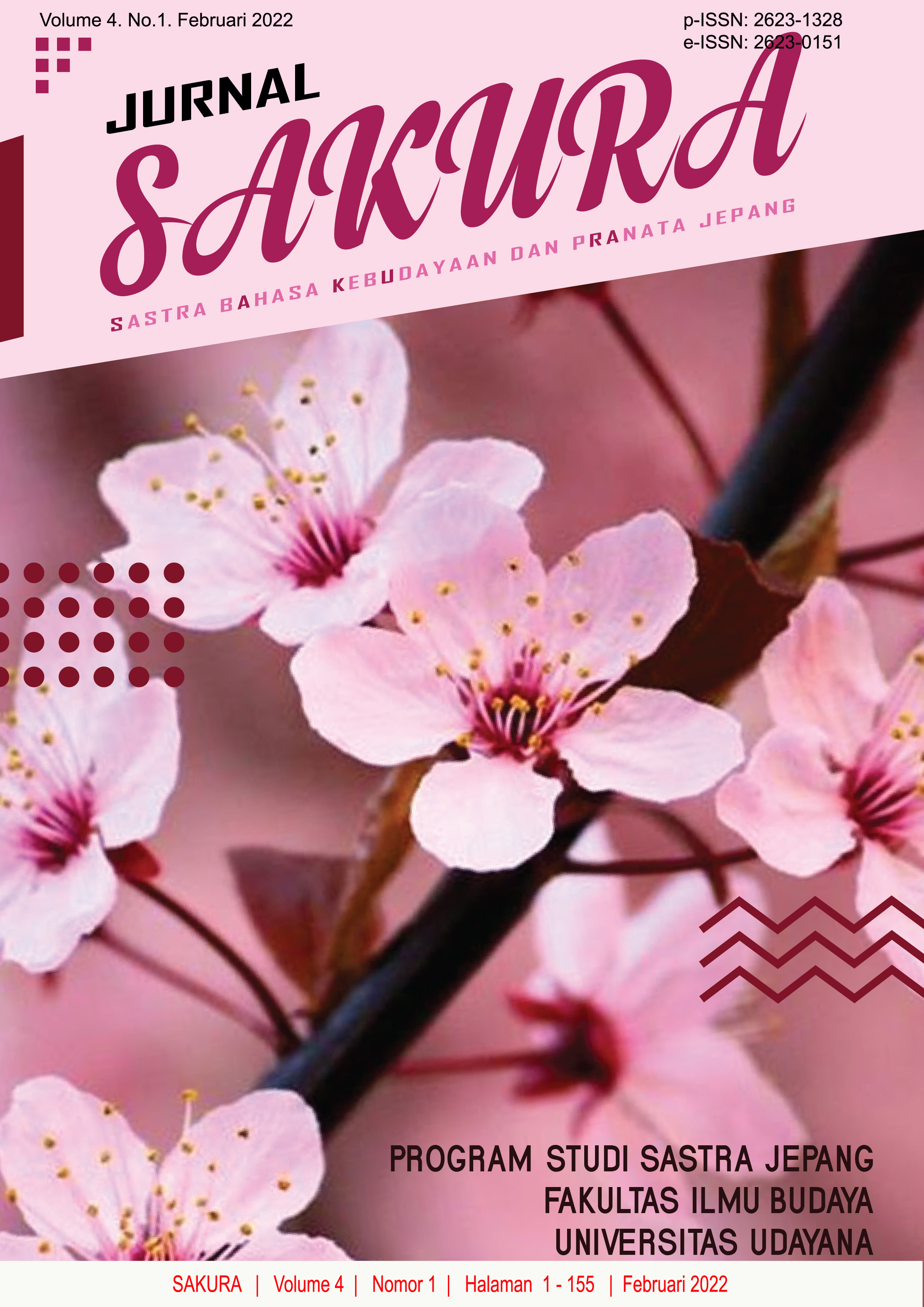Negasi Verba Dialek Osaka Dalam Novel Hibana Karya Matayoshi Naoki
Abstract
This research aims to determine the formation of verb negation and illocutionary speech acts using the Osaka dialect verb negation found in the novel Hibana by Matayoshi Naoki. This research uses morphological theory according to Tsujimura (1999) and illocutionary speech act theory according to Searle (2006). The data collection method used in this research is the observation method, namely by listening to the utterances in comics. Then the data obtained was followed by a note-taking technique. The method used in data analysis was the agih method. Furthermore an informal method is used in presenting the results of the data analysis. Based on the analysis results found six data containing the negation element of the -hen verb and four data containing the element of negation of the verb -hin, the negation of the verb followed by the suffix -hen is formed according to the type of vocabulary. in Japanese, namely godandoushi and ichidan doushi. Ichidandoushi is divided into two, namely kami ichidan doushi which is a verb ending in -iru, and shimo ichidan doushi which is a verb ending in the sound -eru In the verb negation pattern -hen verb only be used for shimo ichidan doushi, -hin can only be used for kami ichidan doushi only, then it is found 13 forms of illocutionary speech acts that use the negation of the Osaka dialect verb which is classified into three data containing elements of assertive speech acts, two data containing elements of directive speech acts, and eight data containing elements of expressive speech acts.
Downloads
References
Fujibayashi. (2001). Hatsuwakoui no Goyouronteki Kenkyuu. [pdf]. http://www2.dokkyo.ac.jp/~esemi008/papers/fujibayashi.pdf
Chaer, Abdul. 2008. Morfologi Bahasa Indonesia (Pendekatan dan Proses). Jakarta: rineka Cipta.
Iori, Isao. (2001). Atarashii Nihongo Gaku Nyuumon, Kotoba no Shikumi wo Kangaeru. Japan: 3 A Corporation.
Natsuko, Tsujimura. 1999. An Introduction to Japanese Linguistics. USA: Blackwell Publishers.
Nurhasanah, Sulastri. 2012. Analisis Settougo fu-, mu-, hi- dan mi- dalam Bahasa Jepang. Jawa tengah: Universitas Negeri Semarang.
Kridalaksana, Harimurti. 2001. Kamus Linguistik. Jakarta: Gramedia Pustaka Utama.
Purba, Julia Kiranta. 2008. Analisis Bentuk Negasi ぬ,ず(に)dan まい Dalam Kalimat Bahasa Jepang (Kajian Morfosintaksis dan Semantik). Bandung: Universitas Kristen Maranatha.
Rohmah, Masyitoh Mawaddah. 2017. Analisis Tindak Tutur Dalam Komik Tokyo Ghoul: Re Karya Ishida Sui. Sumatera: Universitas Sumatera Utara.
Sudjianto dan Ahmad Dahidi. 2007. Pengantar Linguistik Bahasa Jepang. Jakarta: Kesiantblanc.
Tomoko, Morimoto. 2016. Nihongo Nouryokushiken Sougou Tekisuto N4. Japan: J research.
Wedayanti, N. P. L. 2015. Produktivitas kata Harassment Berkomposisi Dalam Bahasa Jepang. PRASI, 10(19).
Wedayanti, N. P. L. 2016. Morphological Process of Suffix-Shi In Japanese
Yamaoka, Masaki. 2006. Hatsuwakoui to Hatsuwa Kinou no Hikaku. International Journal of Pragmatics Vol. XVI: Pragmatics Association of Japan. 7.













